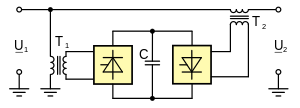Unified power flow controller
A unified power flow controller (UPFC) is an electrical device for providing fast-acting reactive power compensation on high-voltage electricity transmission networks. It uses a pair of three-phase controllable bridges to produce current that is injected into a transmission line using a series transformer.[1] The controller can control active and reactive power flows in a transmission line.

Unified Power Flow Controller (UPFC), as a representative of the third generation of FACTS devices, is by far the most comprehensive FACTS device,[2] in power system steady-state it can implement power flow regulation, reasonably controlling line active power and reactive power, improving the transmission capacity of power system, and in power system transient state it can realize fast-acting reactive power compensation, dynamically supporting the voltage at the access point and improving system voltage stability, moreover, it can improve the damping of the system and power angle stability.
The UPFC uses solid state devices, which provide functional flexibility, generally not attainable by conventional thyristor controlled systems. The UPFC is a combination of a static synchronous compensator (STATCOM) and a static synchronous series compensator (SSSC) coupled via a common DC voltage link.[3]
The main advantage of the UPFC is to control the active and reactive power flows in the transmission line. If there are any disturbances or faults in the source side, the UPFC will not work. The UPFC operates only under balanced sine wave source. The controllable parameters of the UPFC are reactance in the line, phase angle and voltage. The UPFC concept was described in 1995 by L. Gyugyi of Westinghouse.[4] The UPFC allows a secondary but important function such as stability control to suppress power system oscillations improving the transient stability of power system.
References
- Nabavi-Niaki, A.; Iravani, M.R. (2018-12-18). "Steady-state and dynamic models of unified power flow controller (UPFC) for power system studies". IEEE Transactions on Power Systems. 11 (4): 1937–1943. doi:10.1109/59.544667.
- Fuchs, Ewald F.; Masoum, Mohammad A. S. (January 2008). "Unified Power Quality Conditioner (UPQC)". Power Quality in Power Systems and Electrical Machines: 443–468. doi:10.1016/B978-012369536-9.50012-7. ISBN 9780123695369. Retrieved 2019-01-16.
- Sen, K.K.; Stacey, E.J. (2018-12-18). "UPFC-unified power flow controller: theory, modeling, and applications". IEEE Transactions on Power Delivery. 13 (4): 1453–1460. doi:10.1109/61.714629.
- Gyugyi, L.; Schauder, C.D.; Williams, S.L.; Rietman, T.R.; Torgerson, D.R.; Edris, A. (1995). "The unified power flow controller: A new approach to power transmission control" (PDF). IEEE Transactions on Power Delivery. 10 (2): 1085. doi:10.1109/61.400878. Archived from the original (PDF) on 2012-04-26.
- Yao, Liangzhong; Hongfen Cui; Jun Zhuang; Guanjun Li; Bo Yang; Zhibing Wang (May 2016). "A DC power flow controller and its control strategy in the DC grid". 2016 IEEE 8th International Power Electronics and Motion Control Conference (IPEMC-ECCE Asia): 2609–2614. doi:10.1109/IPEMC.2016.7512709. ISBN 978-1-5090-1210-7.
- Purgat, Pavel; Mackay, Laurens; Adilardi Prakoso, Ryan; Ramirez-Elizondo, Laura; Bauer, Pavol (June 2017). "Power flow control converter for meshed LVDC distribution grids". 2017 IEEE Second International Conference on DC Microgrids (ICDCM): 476–483. doi:10.1109/ICDCM.2017.8001089. ISBN 978-1-5090-4479-5.